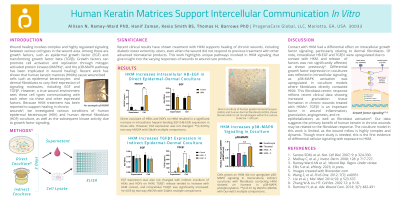Laboratory Research
(LR-017) Human Keratin Matrices Support Intercellular Communication In Vitro

Thomas Barrows, PhD – Chief Scientific Advisor, R&D, ProgenaCare Global; Kesia Smith, BS – Research Associate, R&D, ProgenaCare Global; Hanif Zaman, n/a – Intern, R&D, ProgenaCare Global
Introduction: Recently, there has been increased interest in “real world” clinical evidence in wound care so providers can better understand how wound care innovations will affect their patients. Analogously, laboratory models of wound healing have also improved to better replicate the wound environment. Co-cultures—simultaneously growing different cell types in the same culture system—are one way to reflect native physiology by allowing chemical and physical interactions between cells. In this work, we investigate how a novel advanced wound care product, the human keratin matrix (HKM), affects signaling and growth factor expression in human epidermal keratinocytes (HEKs) and human dermal fibroblasts (HDFs) in a co-culture model.
Methods: HEKs and HDFs were grown in co-culture on HKM-coated surfaces and tissue culture plastic (TCP) surfaces, as well as individually on HKM. We used enzyme-linked immunosorbent assays (ELISAs) to investigate expression of key factors in keratinocyte activation, including epidermal growth factor (EGF) and transforming growth factor beta (TGF-beta). We also quantified proliferation, and measured mitogen-activated protein kinase (MAPK) activity in these cells. All experiments were conducted in triplicate (n=3) and compared by analysis of variance (ANOVA) with Tukey’s multiple comparisons post-test.
Results: In this study, differential expression patterns of keratinocyte activation factors were observed in cells grown in co-culture on HKM. Heparin-binding EGF was significantly upregulated in cells co-cultured in the presence of HKM, and there was a trend of upregulation in TGF-beta expression in dermal fibroblasts when co-cultured with keratinocytes. Interestingly, MAPK activity was not different between co-cultured and monocultured models with HKM.
Discussion: HKM has been demonstrated to promote healing of multiple chronic wound types. While we have previously found differential protein expression in individual cell cultures in the presence of HKM, the present results help further define how HKM may assist in wound healing. Notably, the difference between monocultures on HKM, co-cultures on TCP, and co-cultures on HKM suggest HKM affects both cell-substrate and cell-cell signaling. Further study is needed to elucidate the exact pathways by which this signaling occurs. The lack of significantly different proliferation further suggests that cell activation, including increased migration in keratinocytes and increased matrix remodeling in fibroblasts, may be the predominant mechanism in keratin-mediated wound closure.
Trademarked Items:
References:
Methods: HEKs and HDFs were grown in co-culture on HKM-coated surfaces and tissue culture plastic (TCP) surfaces, as well as individually on HKM. We used enzyme-linked immunosorbent assays (ELISAs) to investigate expression of key factors in keratinocyte activation, including epidermal growth factor (EGF) and transforming growth factor beta (TGF-beta). We also quantified proliferation, and measured mitogen-activated protein kinase (MAPK) activity in these cells. All experiments were conducted in triplicate (n=3) and compared by analysis of variance (ANOVA) with Tukey’s multiple comparisons post-test.
Results: In this study, differential expression patterns of keratinocyte activation factors were observed in cells grown in co-culture on HKM. Heparin-binding EGF was significantly upregulated in cells co-cultured in the presence of HKM, and there was a trend of upregulation in TGF-beta expression in dermal fibroblasts when co-cultured with keratinocytes. Interestingly, MAPK activity was not different between co-cultured and monocultured models with HKM.
Discussion: HKM has been demonstrated to promote healing of multiple chronic wound types. While we have previously found differential protein expression in individual cell cultures in the presence of HKM, the present results help further define how HKM may assist in wound healing. Notably, the difference between monocultures on HKM, co-cultures on TCP, and co-cultures on HKM suggest HKM affects both cell-substrate and cell-cell signaling. Further study is needed to elucidate the exact pathways by which this signaling occurs. The lack of significantly different proliferation further suggests that cell activation, including increased migration in keratinocytes and increased matrix remodeling in fibroblasts, may be the predominant mechanism in keratin-mediated wound closure.
Trademarked Items:
References:

.png)